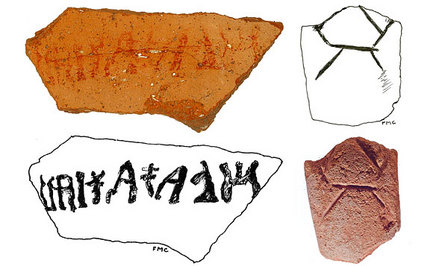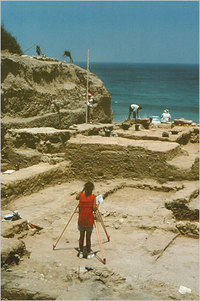 Inscriptions on Philistine pottery are being interpreted as evidence of a Philistine written language. Source of photo: online version of the NYT article cited below.
Inscriptions on Philistine pottery are being interpreted as evidence of a Philistine written language. Source of photo: online version of the NYT article cited below.
Archaeologists have applied more polish to the long-tarnished reputation of the Philistines.
In recent years, excavations in Israel established that the Philistines had fine pottery, handsome architecture and cosmopolitan tastes. If anything, they were more refined than the shepherds and farmers in the nearby hills, the Israelites, who slandered them in biblical chapter and verse and rendered their name a synonym for boorish, uncultured people.
Archaeologists have now found that not only were Philistines cultured, they were also literate when they arrived, presumably from the region of the Aegean Sea, and settled the coast of ancient Palestine around 1200 B. C.
At the ruins of a Philistine seaport at Ashkelon in Israel, excavators examined 19 ceramic pieces and determined that their painted inscriptions represent a form of writing. . . .
. . .
“We had no direct evidence of their early writing,” Dr. Stager said. “We knew they had weights and measures for trading commodities, even precursors of coinage. So we assumed they had some notation or writing system.”
For the full story, see:
(Note: ellipses added.)
 Philistine excavation. Source of photo: online version of the NYT article cited above
Philistine excavation. Source of photo: online version of the NYT article cited above

